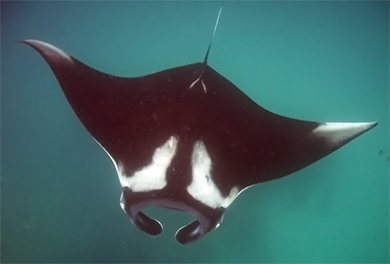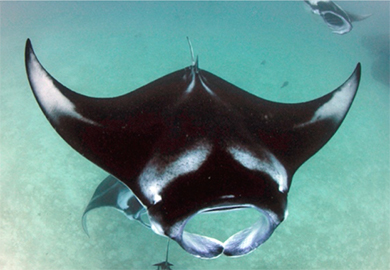Giant manta ray
Introduction
The giant manta ray is the only manta ray recorded from New Zealand. It is common off the northeast coast of North Island from spring to early autumn.Conservation status: NZ Threat Classification – data deficient; IUCN Red List – endangered
Population: Unknown
Found in: Open water across tropical, sub-tropical and temperate latitudes
Threats: Commercial fishing and plastics, fishing lines or other rubbish
Image gallery
Giant manta rays (Mobula birostris) have huge, diamond shaped bodies and swim by beating their ‘wings’ up and down together. They can also beat them in opposite directions – one up, one down.
Although once thought to migrate seasonally to the waters around northern New Zealand, research on other populations in the Indo-Pacific region suggests that the giant manta seen in our waters during spring and summer each year may be resident in this part of the southwest Pacific.
We consider manta rays harmless. But divers have occasionally been towed through the water at high speeds when mantas have become accidentally tangled in their float lines.
How to identify giant manta rays
Giant manta rays have diamond-shaped bodies and two large muscular fins that protrude forward from the head either side of their mouth. These are called their ‘cephalic fins’. They use these for feeding, and roll them up to improve swimming efficiency when not in use.
While rolled up, giant manta rays' cephalic fins resemble horns. This has given rise to their alternative common name of ‘devilfish’.
Manta rays do not have a functional barb or sting on their tail. But the giant manta has a large swelling at the base of the tail close to the dorsal fin where a sting is buried in. This sting has become functionless as they’ve evolved.
If you see a giant manta ray or devil ray, report it to DOC at sharks@doc.govt.nz. You can also support citizen science by reporting giant manta ray sighting to Manta Watch New Zealand.
Similarities with devil rays
Giant manta rays are closely related to the reef manta ray (Mobula alfredi) and their smaller relatives, the devil rays (Mobula spp.).
The reef manta is common throughout the central and western Pacific and Indian Oceans but has not yet been found in New Zealand waters. It differs from the giant manta in having dark spots between the gills on the underside of the body, and the pale shoulder blazes on the upper body angle back towards the tail forming a V-shape. They also do not have a vestigial sting.
The only devil ray so far recorded from New Zealand is the giant or spinetailed devil ray (Mobula mobular; formerly Mobula japanica). It has a dark band over the head, a white tipped dorsal fin, an undershot mouth and a very long, thin tail with a short spine at its base. By comparison the giant manta ray has:
- a much broader head
- larger cephalic fins
- a terminal mouth
- no teeth in the upper jaw
- a faint v-shaped white marking in front of the dorsal fin

Giant mantas’ shoulder markings form a t-shape
Image: Dr Mark Erdmann

Reef mantas’ shoulder markings form a v-shape
Image: Dr Mark Erdmann
Several species of devil ray have a white tip to the dorsal fin, whereas the manta ray’s dorsal fin is all black.
More about this species
Range and habitat
Manta rays occur in open water, in tropical and some warm temperate regions of the world. They live in shallow water close to shore and in the open ocean. Although they spend most of their time swimming, they sometimes rest on the bottom.
Researchers once thought there was only a single globally distributed species of manta ray. However, in 2009 two species were recognised: the giant or oceanic manta, and the reef manta.
Both species are globally distributed. More recent research suggests there is a third species in the Northwest Atlantic.
The giant manta is the only manta ray recorded from New Zealand. It’s been recorded off east and west coasts of the upper North Island, mainly from spring to early autumn. The distribution of reported sightings off the northeast coast closely matches the course of the East Auckland Current.
Very little is known of manta ray movements and habitat use in New Zealand, although the lack of sightings during winter suggests they move offshore, possibly to the north of New Zealand at that time.
Diet and foraging
Little is known of the diet of giant manta rays in New Zealand, although they are often seen feeding on dense patches of zooplankton. To eat, they use the large fins on either side of their head to funnel water containing these tiny organisms into their mouths.
Giant manta rays trap zooplankton on their distinctive filter plates and periodically swallow. These filter plates are attached to the arches of their gills. They often swim in repeated backward loops or ‘somersaults’ to remain in a dense patch of plankton.
Life history
Female manta rays give birth to single pups. Pupping probably occurs during spring. Size at birth is 122-190 cm disc width, and we suspect gestation to be over a year.
Manta rays sometimes jump out of the water. Even large adults are capable of this. The reason manta rays do this is unknown, but it may be to remove parasites or sucker fish (remora).
Manta rays are host to a variety of external parasites. Reef and giant mantas regularly use cleaner stations on coral reefs where reef fishes like damsel and butterfly fishes pick these parasites off them.
The largest accurately measured giant manta ray was 670 cm disc width (wing tip-to-wing tip) but they are reported to reach 910 cm disc width. Individuals estimated to be between 200-790 cm disc width have been reported from New Zealand waters.
Threats to manta rays
Giant manta rays have a small population size and a low birthing rate of only 1 pup every other year. This means they have low resilience to fishing pressure.
Coastal development, pollution and human disturbance also threaten many manta populations. This causes habitat loss, reduces their food sources and disrupts their natural life-cycle.
Manta and devil rays are protected in New Zealand, and there is no reported by-catch of giant manta in our waters. Fisheries targeting manta and devil rays occur in several other countries. These include India, Sri Lanka, Indonesia, and the Philippines.
Manta rays are classified as Endangered globally by the IUCN Red List of Threatened Species.
DOC’s work with manta rays
DOC undertakes research on protected fishes, including manta and devil rays, to improve our understanding of their distribution, overlap with fisheries and to monitor their conservation status.
Giant manta rays are protected under the Wildlife Act 1953. It is illegal to hunt, kill or harm manta rays within New Zealand’s national waters (200 nm limit around New Zealand). Any offence under this Act is liable to a fine of up to $250,000 and six months imprisonment.
Fishers and bycatch
It is not illegal to accidentally catch a manta ray, but it must be released alive and unharmed. Report the catch to DOC and/or Ministry of Fisheries as soon as possible. DOC may ask you to land the dead manta ray for scientific research.
Trade in any part of a manta ray is illegal.
How you can help manta rays
Report sightings to DOC and Manta Watch New Zealand
If you see a giant manta ray, let us know and help guide work that can support and protect them.
Report sightings, strandings or captures to the DOC Marine team by emailing sharks@doc.govt.nz or call 0800 DOC HOT (0800 362 468).
Report your sighting to Manta Watch New Zealand
By reporting your sighting to Manta Watch New Zealand you can support other research on giant manta rays in our waters. This will help confirm if New Zealand has it's own distinct population of giant manta rays and work to estimate their population size.
Inform us if you inadvertently kill a manta ray
Very little is known of the biology of giant manta rays. So dead specimens are of considerable scientific value.
Should you inadvertently kill a giant manta ray, notify DOC. We may ask if you can bring it to shore, if possible. Useful information to provide includes the location and depth that the fish was taken in.
Other ways to help
- Do not buy manta ray products when travelling abroad. You may find manta ray skin used for leather in some products abroad. Some traditional Chinese medicine also use their filter plates from their gills.
- When operating a boat around manta rays, try to minimize the disturbance and risk to them. Travel slowly and quietly and do not obstruct their movements. Avoid load noises or sudden movements.
- Although manta rays may tolerate divers touching them or riding on their backs, avoid interacting with them in this way. It is illegal and can remove the protective mucus layer covering their skin and cause infections and blistering.
- When fishing, carefully release any unwanted sharks and rays.
- Do not throw away plastics, nylon fishing line, and other types of rubbish at sea. Like whales, large filter-feeding sharks and rays can accidentally eat these or become entangled in this debris.

